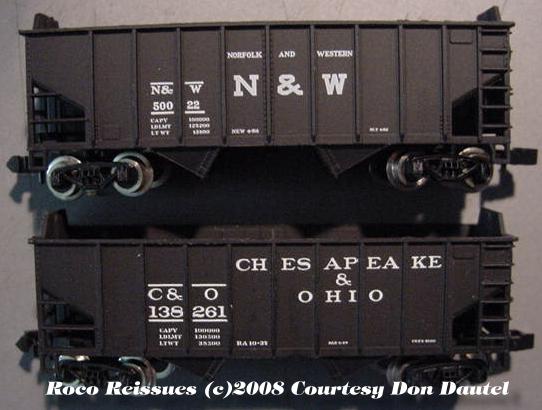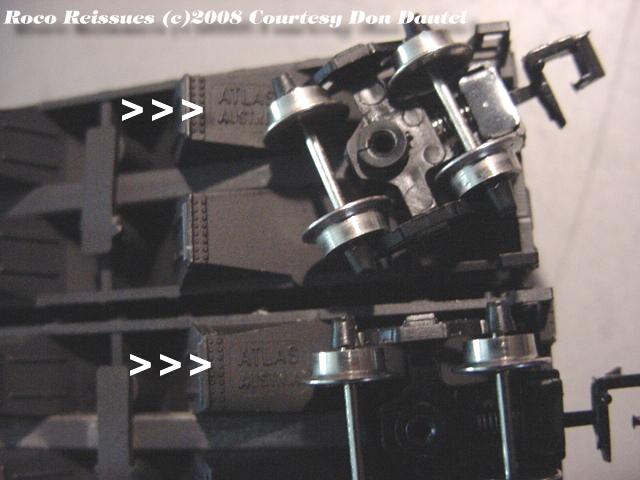A1G 2240 Series: Open Hopper, Steel, 35 Foot, 2 Bay Ribside
Some designs stay around forever. This one has! Originally made in Austria by Roco for Atlas, they've been around ever since for marketers including, most recently, Industrial Rail. In most cases, the familiar "Atlas Austria" will distinguish the A1G versions from all of the other ones, but not all! As it turns out, Roco's re-issues under their own label may come with the "Atlas Austria" imprint, fortunately in different paint schemes. See below for more information on this.
In terms of prototypical fidelity, I haven't done any research, but I doubt it. I'm sure that a real version of this car existed somewhere, or at least real drawings did. In the late 1960's that wasn't really the point. No nitpicking on whether the Pennsy really had peak ends on their ribside hoppers-- or whether the ribsides were a scale foot deep, either.
Of the five 2240s, I'd guess that the Burlington is the hardest to find, but that's relative since these are all easy pickin's for the accumulator. Don't overpay! If you're wondering about that "Peabody Short Line," by the way, it really did exist in Central Illinois, and its primary purpose was hauling coal out of mines for its owner. It's probably one of the most produced paint schemes on N Scale hoppers, with everyone from Life-Like to Kadee Micro-Trains doing it in one form or another... but almost all on yellow hoppers!
There are several variations on these cars, all fairly subtle. For example, there are different lettering thicknesses on the 2241 Soo Line. Wingard calls them the "pinstripe" and "bold" versions in his book and reports that variations of this type also exist on the 2242 Pennsylvania. Although I've never seen them and have just one PRR in the accumulation (right now, anyway), I am including it here. Very subtle indeed is the difference between the "a" and "b" versions of the 2245 Burlington Route although it does seem like "heaviness" of lettering again. You'll need to look carefully at the "Burlington Route" heralds to notice the main difference. On the "a" it's more of a rectangular herald and on the "b" it's more square and closer looking to the prototype. I've got a comparison closeup for you on this page.
When I started to accumulate the A1G series in earnest, I had to procure a second copy of the 2243 Boston and Maine... when just a lad, I "weighted" my first copy with HO scale coal-- glued in solid with lots of Elmer's! Ouch!
Key spotting features for this car are:
- bottom of hopper bay opposite brakewheel stamped "Atlas Austria"
- two bays, deep rib sides, peaked ends (trapezoidal shape)
- original trucks with wheels pressed on seperate axles and Rapido couplers, attached
with "foldover" metal strips
Note: The following information on conditions and "Approximate Value" prices are intended to be a guideline only and is presented with no warranties, express or implied. Caution: Definitions and prices can and do vary with collectors, buyers and sellers, and, of course, whether a person is buying or selling an item. That's the way a "free market" works...
A 2240 series car in "as manufactured" or "AM" condition has:
- all four stirrups intact, peak ends undamaged
- brake wheel in place with no breakage or bending
- no coal load permanently attached (!)
- no weathering
- no abrasions, scratches or other damage to the paint
- the original trucks with the original metal wheels which were fitted to the axles
- "Rapido" type couplers, truck mounted (this is a case where changing to Micro-Trains®
trucks and/or couplers is not a plus!).
Note that minor paint flaws on these cars were common and should not be considered
especially "collectible"; in fact, I'd rather have a "perfect" paint job.
A 2240 series car in "mint in box" or "MIB," meets all "As Manufactured" criteria plus:
- no dust, dirt or wear on the car itself
- no wear on wheels (although discolored wheels are common)
- kept in the original Atlas box
- box itself is intact with no cracks, breakage or crazing, with original Atlas label
(usually white with black printing), plastic liner (usually blue), and cover. Both inserts
and labels vary as the A1G series was sold for years. Store price stickers may or may not
detract depending on the placement, size and wear.
There are no approximate values for "runner" 2240 series cars. Price estimates last updated 02 Jan 2022.
Table of Releases: Where available, click on "Image" to popup an image of the actual car.
Approximate Values Updated July, 2024.
| Catalog # | Popup Image |
Reporting Marks |
Description | AV AM |
AV MIB |
|---|---|---|---|---|---|
| 2241a | Image | SOO LINE 4708 | BCR/White, Large Roadname Across Heavy Lettering | 5-7 | 7-9 |
| 2241b | Image | SOO LINE 4708 | BCR/White, Large Roadname Across Thin Lettering | 6-8 | 9-12 |
| 2242a | Image | PRR 665000 | Black/White, Roadname Across, Herald L Heavy Lettering | 5-7 | 7-9 |
| 2242b | - | PRR 665000 | Black/White, Roadname Across, Herald L Thin Lettering | 5-7 | 7-9 |
| 2243 | Image | B&M 71717 | Blue/White, Rep Mks L, B+M Herald R | 5-7 | 7-9 |
| 2244 | Image | PSL 6671 | Yellow/Green, "Peabody Short Line" Across | 5-7 | 7-9 |
| 2245a | Image | CB&Q 172700 | Red/White, R/M L, Roadname Across, Herald R Rectangular Herald, Heavy Ltr | 5-7 | 7-9 |
| 2245b | Image | CB&Q 172700 | Red/White, R/M L, Roadname Across, Herald R Square Herald, Thin Ltr | 5-7 | 7-9 |
See a popup image comparison of the 2245a and 2245b Burlington hoppers here.
AV = Approximate Value (US$ range)
AM = As Manufactured (see above)
MIB = Mint In Box (see above)
Abbreviations: Hld=Herald, R/N=Roadname, R/M=Reporting Marks, "FCR"=Freight Car Red (Brown), L/R=Left/Right Side of Car Life after A1G: The Roco Reissues
The same January 1987 issue of Model Railroader which announced the return of the (Despatch) Stock Cars also had on Page 158b an advertisement of the return of this car under the Roco banner, marketed (at least in the USA) by Walthers. "These late steam/early diesel cars are fully assembled with trucks and Rapido type couplers. Each is painted and lettered in authentic colors." When released, these had a list price of $5.98. Here's a table of these cars.
| Catalog # | Popup Image |
Reporting Marks |
Description |
|---|---|---|---|
| 28725 | C&O 138201 | Black/White, Reporting Marks L, 1930s Style Roadname R | |
| 28726 | N&W 50022 | Black/White, Reporting Marks L, Small Roadname + Large "N&W" Center | |
| 28727 | CRR 47569 | Black/White, Reporting Marks L, Clinchfield Roadname Top Center | |
| 28728 | VGN 9501 | Black/White, Reporting Marks L, Round WGN Herald Top L, Roadname Center | |
| 28729 | L&N 82204 | Brown/White, Reporting Marks L, 'Dixie Line' Slogan R | |
| 28730 | BN 513284 | Black/White, Roadname + Reporting Marks L, Large Herald R |

